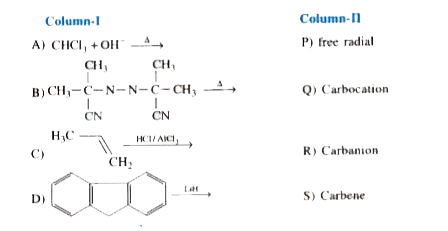Nucleophiles donate a free electron pair to the electron deficient centre of the organic substrateSolution in Telugu
Step by step video & image solution for Nucleophiles donate a free electron pair to the electron deficient centre of the organic substrate by Chemistry experts to help you in doubts & scoring excellent marks in Class 11 exams.
Updated on:21/07/2023Topper's Solved these Questions
- GENERAL ORGANIC CHEMISTRYBOOK - AAKASH SERIESCHAPTER - GENERAL ORGANIC CHEMISTRYEXERCISE - Objective Exercise -1
204 Videos
- GENERAL ORGANIC CHEMISTRYBOOK - AAKASH SERIESCHAPTER - GENERAL ORGANIC CHEMISTRYEXERCISE - Objective Exercise -2
82 Videos
- GENERAL ORGANIC CHEMISTRYBOOK - AAKASH SERIESCHAPTER - GENERAL ORGANIC CHEMISTRYEXERCISE - Subjective Exercise -7
8 Videos
- ENVIRONMENTAL CHEMISTRYBOOK - AAKASH SERIESCHAPTER - ENVIRONMENTAL CHEMISTRYEXERCISE - EXERCISE ON PASSAGE (PASSAGE-III)
5 Videos
- HYDROCARBONSBOOK - AAKASH SERIESCHAPTER - HYDROCARBONSEXERCISE - ADDITIONAL PRACTICE SHEET ( LEVEL-II (PRACTICE SHEET (ADVANCED) (MATRIX MATCHING TYPE QUESTIONS)))
5 Videos
Similar Questions
Urea was prepared first time in the laboratory by heating
View SolutionThe compound containing sp sp2 and sp3 hybridised carbon atoms in 1:2:3 ratio is
View SolutionExplain (a) column chromatography, (b) thin layer chromatography and (c ) partition chromatography
View SolutionOzone layer acts as one of the most important life support system. The major cause of ozone layer destruction is believed to be the release of chlorofluorocarbon compounds. UV radiation causes the chlorofluouocarbons to dissociate : CF2Clhv−−→Cl⋅+CF2CI A highly reactive chlorine atomis responsible for the decomposition of ozone. Cl⋅+O3(g)→ClO⋅+O2(g)ClO⋅+O(g)→Cl⋅+O2(g) Free radicals of chlorine decompose ozone molecules in a chain reaction. The depletion of ozone layer leading to ozone hole has, however, been mainly observed in the stratosphere over Antarctica. Special type of cloud called polar stratospheric colouds are formed over Antarctica.These clouds (contain solid HNO3.3H2O) play an important role in ozone depletion.
ClO⋅+NO2→ClONO2
ClONO2+H2O→HOCl+HNO3
ClONO2+HCl→Cl2+HNO3
HOClhv−−→HO⋅+Cl⋅
The reactive chlorine atoms thus formed are rendered to deplete ozone layer.
The ozone layer is present in :
View SolutionMatch the intermediates formed in the reaction.

View SolutionAssertion: in comparison to ethyl chloride it is difficult to carry out nucleophilic on vinyl chloride
Reason: Vinyl group is electron-donating .
View SolutionElectron pair donating tendency is maximum in-
View Solution(A) Carbonyl compounds take part in nucleophilic addition reactions.
(R) These reactions are initialed by nucleophilic attack at the electron deficient carbon atom.
View Solutionन्यूक्लियोफाइल लुईस …………… होते है तथा इनमे इलेक्ट्रॉनों के …………. युग्म उपस्थित होते है।
View SolutionElectron donating groups are,
View SolutionWhich is NOT the correct statement/s for the nucleophilic reagents?
(i) They are electron loving species
(ii) They attack the positive centres as they are negatively charged.
(iii) They are Lewis acids.
(iv)They donate lone pair of electrons
View SolutionA specis that . Donates the electron pair pf H^(@) is termed as a / an _______.
View SolutionA: dien is bidentate ligand.
R:dien donates two pairs of electron
View SolutionElectrophiles are electron deficient and attack the substrate where the electron density is more
View SolutionThe products of bond breaking, shown below, are not stable, and cannot be isolated for prolonged study. Such species are referred to as reactive intermediate, and are belived to be transient intermediates in many reactions. The general structures and names of four such intermediates are, Charged Intermediates Uncharged Intermediates Carbocations (called carbonium ions in the older literature) are electrophiles and carbananions are nucleophiles. Carbenes have only a valence shell sextet of electrons and are therefore electron deficient. In this sense they are elecrophiles, but the non-bonding electron pair also gives carbenes nucleophilic character. As a rule, the electrophilic character dominates carbene reactivity. Carbon radicals have only seven valence electrons, and may be considered electron deficient, however, they do not in general bond to nucleophilic electron pair, so their chemistry exhibits differences from that of conventional electrophiles. Radical intermediates are often called free radicals. Intermediates are in general stabilised with conjugation, electron donating and electron with drawing groups. Which of the following is relatively an unstable intermediate compared to rest ?
View Solution
